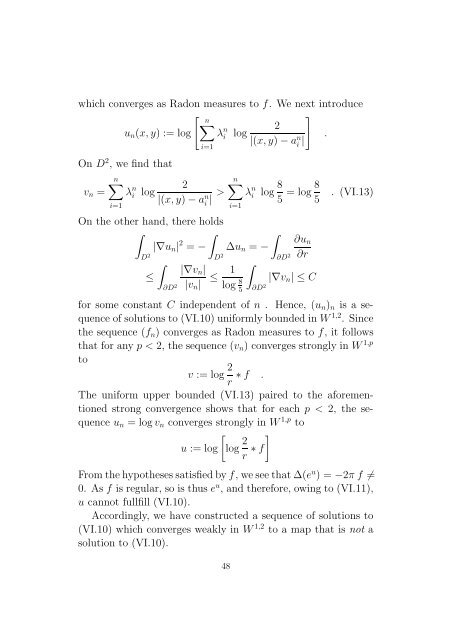Conformally Invariant Variational Problems. - SAM
Conformally Invariant Variational Problems. - SAM
Conformally Invariant Variational Problems. - SAM
Create successful ePaper yourself
Turn your PDF publications into a flip-book with our unique Google optimized e-Paper software.
which converges as Radon measures to f. We next introduce<br />
[ n∑<br />
]<br />
u n (x,y) := log λ n 2<br />
i log<br />
|(x,y)−a n i=1<br />
i | .<br />
On D 2 , we find that<br />
n∑<br />
v n = λ n 2<br />
n∑<br />
i log<br />
|(x,y)−a n i | > λ n i log 8 5 = log 8 5<br />
i=1<br />
i=1<br />
On the other hand, there holds<br />
∫ ∫ ∫<br />
|∇u n | 2 ∂u n<br />
= − ∆u n = −<br />
D 2 D 2 ∂D ∂r<br />
∫<br />
2 |∇v n |<br />
≤ ≤ 1 ∫<br />
∂D |v 2 n | log 8 |∇v n | ≤ C<br />
5 ∂D 2<br />
. (VI.13)<br />
for some constant C independent of n . Hence, (u n ) n is a sequence<br />
of solutionsto (VI.10)uniformlybounded in W 1,2 . Since<br />
the sequence (f n ) converges as Radon measures to f, it follows<br />
that for any p < 2, the sequence (v n ) converges strongly in W 1,p<br />
to<br />
v := log 2 r ∗f .<br />
The uniform upper bounded (VI.13) paired to the aforementioned<br />
strong convergence shows that for each p < 2, the sequence<br />
u n = logv n converges strongly in W 1,p to<br />
u := log<br />
[log 2 ]<br />
r ∗f<br />
Fromthehypothesessatisfiedbyf,weseethat∆(e u ) = −2πf ≠<br />
0. As f is regular, so is thus e u , and therefore, owing to (VI.11),<br />
u cannot fullfill (VI.10).<br />
Accordingly, we have constructed a sequence of solutions to<br />
(VI.10) which converges weakly in W 1,2 to a map that is not a<br />
solution to (VI.10).<br />
48
















